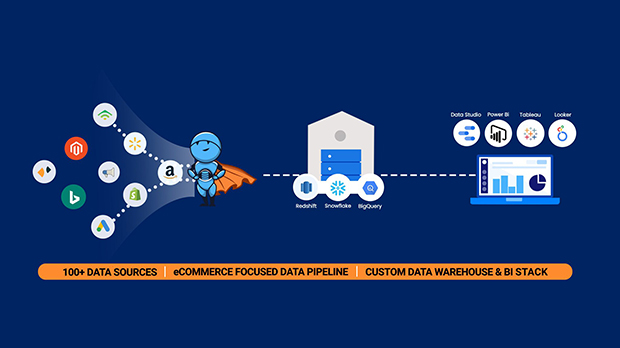Over 175 ZB of data will be created globally by 2025, with over 30% of new insights generated in real-time. The rapid expansion of the data world creates significant prospects for eCommerce merchants. Big data in eCommerce may be utilized to save expenses at every level of the operational lifecycle and provide more substantial consumer insights to company executives.
Any fast-growing eCommerce company needs a high-quality data warehouse. A data warehouse offers the capacity to aggregate data from these sources to draw actionable insights from:
- Procurement
- Sales and marketing
- Inventory
- Logistics
- Product Development and other Sources
eCommerce brands can obtain more profound insights, enhance decision-making quality, and fulfill their demand for data while extracting value from it.
Why do eCommerce Brands Need Better Data and Analytics Solutions
Improving the online user experience is the primary objective for 97% of company executives in 2022. However, 71% are unsure where to start when it comes to understanding consumer behavior. After working with numerous eCommerce brands over five years, we realized that most eCommerce brands have set up neither systems nor resources to funnel all their data into a single location.
This often results in brands’ ability to address important eCommerce targeted queries. Data from multiple sources is often scattered across departments and presented in spreadsheets.
When asked for actionable insights, finding answers to those questions is a complex activity in data aggregation, data modeling, and analysis. We believe that growing brands must operate an eCommerce Data Warehouse. If the eCommerce team has no data analysts/decision support analysts in place or has not engaged a firm like us specializing in the data warehouse space, deep questions are not getting answered.
In most situations, data is extracted from diverse sources, including external ones. As a result, before you can use this data for analytics, you must first consolidate and have full ownership of the data. This is where a data warehouse comes into play. Apart from assuring constant access to internal marketing data, data warehouses may also be set up to contain analysis-ready data for:
- Development of business continuity scenarios
- Optimization of logistics and last-mile delivery
- Personalization and product suggestions in real-time
- Management and optimization of the supply chain
- Modeling of advanced consumer behavior
- Predictions of demand and buying patterns
- Cost agility through process optimization scenarios
Finally, a data warehouse allows eCommerce businesses to better plan, forecast, and respond to changing client requests and solve attribution challenges using data analysis.
Sample Interactive Dashboards which can be custom-branded, and tailored to meet your/your clients’ reporting requirements on any warehouse and BI stack
View Dashboards
What departmental-level challenges can be addressed by data warehousing
Sales
eCommerce businesses tend to be multi-channel as it is essential to be present where their customers are shopping, which means selling on their website, on Amazon.com, and having their products in big box stores, among other presences.
Selling on multiple channels naturally creates data silos for sales data. Unless the data is aggregated, it will be challenging to determine how they are doing across all channels and what their profitability across channels looks like.
Marketing
For reporting on overall marketing performance, marketers typically resort to spreadsheets. They run reports on various ad platforms like Facebook Ads, Pinterest, Google Ads, analytics platforms like Google Analytics, and eCommerce platforms like Shopify, BigCommerce, and Magento.
They download those reports to their laptop or computer, perform some data manipulation, and put together a set of manual reports that reflect marketing performance. To report actuals against targets involve manipulating another set of spreadsheets. These spreadsheets get emailed on a daily/weekly basis to management teams. Some companies may have achieved a degree of automation in this space by using specialized marketing tools.
Other departments tend to be not that lucky because they typically do not have the marketing department’s budget to acquire tools to help them with reporting.
Customer Service
Customer service is an eCommerce company’s most important yet underrated aspect. Considering how expensive it is to acquire customers and that a customer may not be profitable for the business until they repurchase, it is vital to retain customers.
It is essential for management teams to keep an eye on the overall performance of the customer service department, the sentiment expressed by customers, and the quality of work done by individual customer service reps. Modern businesses typically use three to four channels to engage with customers. These channels include services like Intercom, Live Agent, or Fresh chat for onsite chat support, Zendesk or Freshdesk to handle incoming customer service requests, and contact center software like Nectar Desk and Avoxi.
For the manager of a customer service team, it is a daily chore to look at a few different systems to arrive at their final report on the performance of the customer service desk. Once they aggregate all the data from the onsite chat, customer service desk software, CRM data, and transaction data, they could assess if shipping prompted complaints, if a product return happened due to a size issue or a quality issue, or for some other reason.
Management and marketing teams should care about customer service and work closely with customer service to ensure that many customers who interact with customer service turn around and engage more with the business.
In a time when a minor discomfort caused to a customer makes its way to social media and causes irreparable damage to the brand, a week-long delay may be too long. Customer service plays a massive role in customer retention.
Data Warehousing is the Future of eCommerce Data and Analytics
One of the most important requirements was to be as flexible as possible to deal with company changes and receive quick answers to business inquiries. Bringing data from multiple sources – the cloud, databases, applications, and elsewhere – into the data warehouse using Daton & Daton-powered solutions means it can now be accessed without further development work.
Data pipeline management that runs perfectly
With Daton, an eCommerce company can now manage its data integration pipelines more efficiently and reliably. Daton guarantees that the data warehouse receives daily updates in real-time, allowing each department to use core data and create their business-critical reports. The company management thoroughly examined costs, margins, and pricing promotions reports. Sales analytics, logistics, and delivery, as well as shipping, cost management, and vendor analyses, may all be continually optimized.
Daton: The Data Replication Superhero
Contact us today about your reporting and analytics challenges. We can integrate data from multiple marketplaces, channels, platforms, and software, giving you a single truth source and complete data ownership in a customizable stack.













